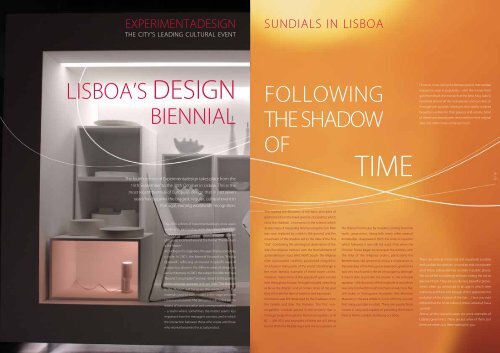lisboa city lisboa city
lisboa city lisboa city
lisboa city lisboa city
You also want an ePaper? Increase the reach of your titles
YUMPU automatically turns print PDFs into web optimized ePapers that Google loves.
EXPERIMENTADESIGN<br />
THE CITY’S LEADING CULTURAL EVENT<br />
LISBOA’S DESIGN<br />
BIENNIAL<br />
The fourth edition of Experimentadesign takes place from the<br />
15th September to the 30th October in Lisboa. This is the<br />
most recent biennial of European design that in just seven<br />
years has become the biggest, regular, cultural event in<br />
Portugal, earning worldwide recognition.<br />
The 2005 edition of Experimentadesign, once again<br />
working in partnership with the Lisboa Municipal<br />
Council and with the support of the Portuguese Ministry<br />
of Culture, is centred around the theme “The Medium<br />
is the Matter”.<br />
According to the organisers, this year’s theme completes<br />
a cycle. In 2001, the biennial focused on “Modus<br />
Operandi”, reflecting an interest in specific ways of<br />
producing culture in the different areas of design, art<br />
and architecture. In 2003, the subject for reflection was<br />
“Beyond Consumption” and was related to the position<br />
of the consumer, spectator and user. Now, “The Medium<br />
is the Matter” will focus on the medium and the<br />
materials used for transmission in the stage between<br />
creator and receiver. The discussion will centre on the<br />
means of communication and communicative objects<br />
– a realm where sometimes the matter seems less<br />
important than the message it conveys, and in which<br />
the interaction between those who create and those<br />
who receive becomes the actual product.<br />
SUNDIALS IN LISBOA<br />
FOLLOWING<br />
THE SHADOW<br />
OF<br />
This marked the discovery of the basic principles of<br />
gnomonics (from the Greek gnomon, the pointer, which<br />
casts the shadow). Gnomonics is the science which<br />
studies ways of measuring time by using the Sun. Man<br />
was soon replaced by a stick in the ground, and the<br />
movement of the shadow led to the idea of the first<br />
“dial”. Combining the astrological observation of the<br />
skies (for religious motives) with the first rudiments of<br />
spatial direction – East, West, North, South - the religious<br />
elite constructed carefully positioned megalithic<br />
structures in many parts of the world. Stonehenge is<br />
the most famous example of these stone circles.<br />
However, many more of this species of giant sundial<br />
exist throughout Europe, Portugal included, stretching<br />
as far as the Atlantic, and at certain times of the year<br />
they still mark the time of solstices and equinoxes.<br />
Gnomonics was first developed by the Chaldeans, then<br />
the Greeks and later the Romans. The first nonmegalithic<br />
sundials arrived in the territory that is<br />
Portugal today through the Roman occupation (218<br />
BC. – 409 AD.) and examples of these are still being<br />
found. With the Middle Ages and the occupation of<br />
TIME<br />
the Iberian Peninsular by invaders coming from the<br />
north, gnomonics , along with many other areas of<br />
knowledge, disappeared. With the Arab occupation<br />
which followed, it was still not used. Only when the<br />
Christian forces began to reconquer the territory, with<br />
the help of the religious orders, particularly the<br />
Benedictines, did gnomonics enjoy a renaissance. In<br />
the early days of the Portuguese expansion, gnomonics<br />
was very much used in the art of navigating, although<br />
it wasn’t able to provide the answer to the principle<br />
question – the discovery of the longitude at sea (which<br />
was only resolved through mechanical watches). But,<br />
still today, in Portuguese museums (the Maritime<br />
Museum, in the area of Belém, is one of them), one can<br />
find many portable sundials. These are usually finely<br />
carved in ivory and capable of providing the time in<br />
Paris or Rome, London, Hamburg or Lisboa.<br />
However, it was during the Baroque period, that sundials<br />
enjoyed a surge in popularity – with the money from<br />
gold from Brazil, the monarch at the time, King João V,<br />
furnished almost all the monasteries and convents in<br />
Portugal with sundials. Moreover, the nobility ordered<br />
beautiful sundials for their palaces and estates. Most<br />
of these have already been removed from their original<br />
sites, but others have remained in tact.<br />
There are vertical, horizontal and equatorial sundials<br />
and sundials for solstices, or sundials that incorporate<br />
all of these. Lisboa also has sundials in public places.<br />
We would like to challenge all those visiting the <strong>city</strong> to<br />
discover them. They are usually very beautiful pieces,<br />
which often go unnoticed in an age in which time<br />
rushes by and there isn’t enough of it to appreciate the<br />
evolution of the shadow of the Sun… Have you ever<br />
noticed that the Sé de Lisboa (Lisboa Cathedral) has a<br />
sundial?<br />
Above, on the opposite page, are some examples of<br />
Lisboa’s gnomonics. These are just a few of them, but<br />
there are others out there waiting for you.<br />
28 _<br />
29


